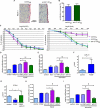Local MicroRNA Modulation Using a Novel Anti-miR-21-Eluting Stent Effectively Prevents Experimental In-Stent Restenosis
- PMID: 26183619
- PMCID: PMC4552606
- DOI: 10.1161/ATVBAHA.115.305597
Local MicroRNA Modulation Using a Novel Anti-miR-21-Eluting Stent Effectively Prevents Experimental In-Stent Restenosis
Erratum in
-
Correction.Arterioscler Thromb Vasc Biol. 2015 Oct;35(10):e51. doi: 10.1161/ATV.0000000000000024. Arterioscler Thromb Vasc Biol. 2015. PMID: 26399923 No abstract available.
Abstract
Objective: Despite advances in stent technology for vascular interventions, in-stent restenosis (ISR) because of myointimal hyperplasia remains a major complication.
Approach and results: We investigated the regulatory role of microRNAs in myointimal hyperplasia/ISR, using a humanized animal model in which balloon-injured human internal mammary arteries with or without stenting were transplanted into Rowett nude rats, followed by microRNA profiling. miR-21 was the only significantly upregulated candidate. In addition, miR-21 expression was increased in human tissue samples from patients with ISR compared with coronary artery disease specimen. We systemically repressed miR-21 via intravenous fluorescein-tagged-locked nucleic acid-anti-miR-21 (anti-21) in our humanized myointimal hyperplasia model. As expected, suppression of vascular miR-21 correlated dose dependently with reduced luminal obliteration. Furthermore, anti-21 did not impede reendothelialization. However, systemic anti-miR-21 had substantial off-target effects, lowering miR-21 expression in liver, heart, lung, and kidney with concomitant increase in serum creatinine levels. We therefore assessed the feasibility of local miR-21 suppression using anti-21-coated stents. Compared with bare-metal stents, anti-21-coated stents effectively reduced ISR, whereas no significant off-target effects could be observed.
Conclusion: This study demonstrates the efficacy of an anti-miR-coated stent for the reduction of ISR.
Keywords: coronary restenosis; hyperplasia; microRNAs; rats; stents.
© 2015 American Heart Association, Inc.
Figures




Comment in
-
Local Anti-miR Delivery: The Latest in the Arsenal of Drug-Eluting Stents.Arterioscler Thromb Vasc Biol. 2015 Sep;35(9):1905-6. doi: 10.1161/ATVBAHA.115.306187. Arterioscler Thromb Vasc Biol. 2015. PMID: 26310808 Free PMC article. No abstract available.
References
-
- Owens GK, Kumar MS, Wamhoff BR. Molecular regulation of vascular smooth muscle cell differentiation in development and disease. Physiological reviews. 2004;84:767–801. - PubMed
-
- Owens GK. Regulation of differentiation of vascular smooth muscle cells. Physiological reviews. 1995;75:487–517. - PubMed
-
- Aikawa M, Sakomura Y, Ueda M, Kimura K, Manabe I, Ishiwata S, et al. Redifferentiation of smooth muscle cells after coronary angioplasty determined via myosin heavy chain expression. Circulation. 1997;96:82–90. - PubMed
-
- Yoshida T, Owens GK. Molecular determinants of vascular smooth muscle cell diversity. Circulation research. 2005;96:280–291. - PubMed
Publication types
MeSH terms
Substances
Grants and funding
LinkOut - more resources
Full Text Sources
Research Materials

